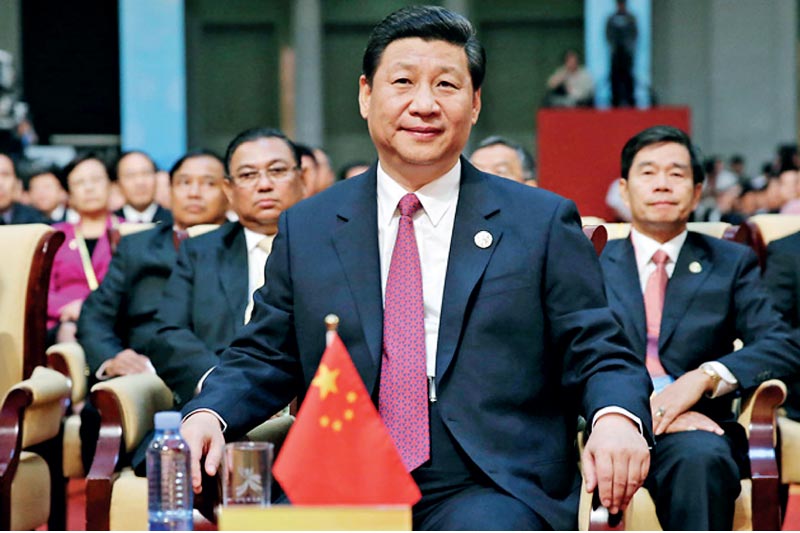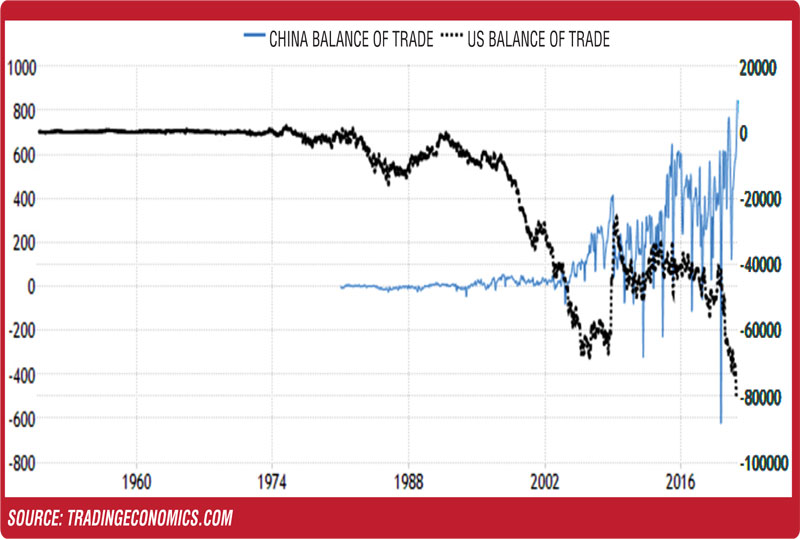Friday Dec 05, 2025
Friday Dec 05, 2025
Saturday, 27 November 2021 01:27 - - {{hitsCtrl.values.hits}}

Over the years since 1989, China has strengthened its economy, challenging the US, Euro bloc and the entire world on many fronts and simultaneously improving key indices
 Abstract
Abstract
The emergence of China as a market economy, leaving behind the Bamboo Curtain and out from the totalitarian dictatorship regime, was welcomed by the US and Westerners at large in early 1989. The transformation to a market economy had shifted the world opinion from human rights perspective to socio-economic liberalisation where it would lead to political and personal liberalisation.
At the outset, the move was seen primarily as one-way flow of ideas and goods into China, transforming the life in China. Despite the welcoming by the West, the expectations were optimistic and mixed, and created to rethink, and most importantly the impact on the world.
Very recently the brewing conflict between US and China centred round Taiwan was widely reported in international media. Before reading between the lines, it is relevant and appropriate to look back and understand China’s elevation as world super power within a couple of decades. The writer believes that the strength gained through economic and the financial prosperity led to build the pathway for supremacy.
Introduction
In mid to late 1989, I had the opportunity to associate with Chinese engineers on various technical fora and also to visit China for a month’s stay after the Tiananmen Square massacre (TSm). What I experienced and gathered were a very bleak picture especially in the lives of ordinary citizens.
A couple of engineers asked me whether we, Sri Lanka, could organise short-term consultancy assignments either through ITU or APT to earn a bit of foreign exchange towards improving living conditions. Most of them were living in tiny apartments where families had to manage available space with difficulty in cramped houses.
While staying in Beijing, China, I used cycling, the popular mode of transport amongst the Chines then, for short-term commutes and exchanged USD at a higher rate to domestic Yuan for our expenses. It was not an unfamiliar scene to the current Sri Lanka situation where all the vehicular traffic was parked, clearing roadway for the movement of top brass of China.
Apparent strategy
Nevertheless, reforms aimed for liberalisation of market economy, announced prior to Tiananmen Square massacre, had turned into one-way street post TSm era. Later refocused and developed the pathway to supremacy through trade and becoming a leading trading partner across many continents. This led to capture traditional markets, YoY (Year-on-Year) growth of trade surpluses, and foreign exchange reserves despite minor fluctuations recently experienced as a result of COVID-19 pandemic.
On scrutinising the key economic indices, such as balance of trade and foreign exchange reserves, and comparing them with US and Euro Union, it was clear how much of hard work China has pursued to capture and infiltrate into those markets, credit goes to the dedication and genuine hard work of Chinese folks, despite complaints of unethical practices.
The massive growth of earnings has been strategically deployed to fund for development activities and build assets of several countries. By this way China had managed to stamp its presence in many countries, which subsequently led to the Belt and Road Initiative.
Performance statistics
Over the years since 1989, China has strengthened its economy, challenging the US, Euro bloc and the entire world on many fronts and simultaneously improving key indices. The Chinese were able to navigate successfully the external turbulences that cropped up as a result of the ongoing trade war with West and its allies. Although this was the case, the world had kept very close scrutiny on the Chinese and all of their activities.
It is interesting to observe the strong performance of China through the lens of economic progress over the past two decades and compare with the rest of leading countries.
a. Economic growth and GDP;
b. Competitiveness of Chinese products and services offerings;
c. Lifting people out of poverty (steep rise in GDP per capita), recently has been seen the increase of Chinese tourist and visitors. On comparing with US, there was a steady decline of GDP per capita since year 2019;
d. Becoming a leading trading partner, export earnings growth with surplus as opposed to US trade deficit;
e. Growth of balance of trade and foreign reserves, YoY basis;
f. Outward FDIs; and
g. Inward FDIs, although this was recently affected due to the trade war with the West
In addition, the Chinese have gained bargaining power and influence in all United Nations activities, Security Council, WHO, etc.
The graph was taken as an example to illustrate and compare the Balance of Trade (BoT) of China vs. the US. Prior to 1989 there was practically nil BoT in China and since then a gradual surge of surplus to the current level of $ 84.54 billion in October 2021 as opposed to the deficit recorded in $ 80.9 billion in September of 2021, amid fall in exports while imports jumped to an all-time high; this is a worrying trend for US and a hard task to reverse as it is likely to affect countries in Asia and South East Asian region those who have high Chinese FDI instances.
To further consolidate the aforementioned argument in terms of outward FDIs, the following has been extracted from two websites illustrating the Sri Lankan perspective.
In 2019, the value of cumulative Chinese infrastructure investment in Sri Lanka was equivalent to 14% of Sri Lanka’s GDP, surpassing India’s comparable $ 1.2 billion in investment (Chatham House, March 2020; Indian Ministry of External Affairs, September 2019). At the same time, Chinese imports to Sri Lanka have grown consistently since 2011, and in 2019 were roughly comparable with India’s (The Diplomat, 1 August 2019). In short, while Indian economic relations with Sri Lanka have either remained steady or weakened, trade, investment and foreign aid ties with China have grown rapidly in the last few decades.
Worrying trends
a. Have seen recently unprecedented levels of Chinese outward FDIs, especially for vulnerable economies in the guise of stimulating growth, those countries are being indebted and trapped without any self-rescue; tangible homegrown schemes other than to be an indefinite beneficiary of China;
b. Predominant and well-orchestrated cyber-attacks launched from China – espionage;
c. Indebtedness is used as a launching pad in interfering with respective governments – e.g. Chinese Government interfering with Sri Lanka to accept the substandard fertilise ship despite it was rejected by Sri Lankan agriculture authority;
d. Surrender assets to China at a marginally low cost in the event there is no foreseen Return on Investments. Failing to service loans taken at marginally high rate;
e. Physical control of critical assets and stamp the presence for future atrocities and adversities and counter any threats;
f. Violation of Intellectual Property Rights costing manufacturing industries of US and West;
g. No respect for human rights, Chinese administrations have stolen the basic rights of its people, become the right exercised by the administration. Whistle-blowers are bumped into oblivion safeguarding the interest of top few and the communist doctrine; and
h Leveraging all above facts to build and enhance One Road One Belt (OROB) across many regions and continents. This has seen as Chinese Monroe Doctrine where it exercises Chines colonisation, especially, in the Asian bloc.
Warmongering attitude
Each country has its own policies and prerogative to protect their own interests; sometimes they may go against the wishes of another country. Lately and in the recent past we have witnessed Chinese responses to that had gone against their expectations; retaliations in terms of trade sanctions, destabilising financial markets by way of pulling out their investments, etc.
China’s excellent financial performance over the years has made a platform for negative activities towards developed nations and also acting in disguise as a beneficiary for developing countries to spread their wings for their ulterior motives and achieve the goals.
Recently, while addressing the nation, the Chinese President said China will not tolerate bullying from any foreign forces, if so, quote, it would “bash heads bloody against great wall of steel” unquote. Such nationalist statements demonstrate the appetite for war with no hesitation of any consequences.
Military build-up in South China Sea
It apparent that the Chinese are building up military capability in the South China Sea to annex Taiwan to the mainland of China either by peaceful means or by invading. The Chinese believe Taiwan is historically a part of China and never believed the declaration of independence after the 1949 Chinese civil war. However, Chinese are cautious of American support to Taiwan in the event of China opting to go for war.
It has been reported that Chinese military spending is unparalleled and alarming, modernising the capabilities and strengthen the presence by building artificial islands in the coast to the size of 1,300 hectares. Have also seen lately testing ballistic and long-range missile by China. Recent satellite images show movement of heavy weaponry that includes development of land, sea and air launched missiles to repel and possibly sink opposing vessels; expressed most emphatically by land-based DF-21D ballistic missiles also known as “carrier killer”.
There are multiple views of this looming war, some believe US and its allies will defend in the event of invasion by China despite cost, to maintain the strategic credibility; the opposite view was it is a dangerous ploy to go for military confrontation as nothing will be achieved rather than a human and economic catastrophe which might turn in to the WWIII of the century and ripples out to the entire world.
Why Taiwan is important to China
China believes that the domination and influence of West in the region as a threat to China’s progress, hence believe occupation of Taiwan is an effective solution considering:
a. Strategic geographical location of Taiwan where, China could threaten and target US with long range ballistic missiles in the event of
conflict;
b. Curb strong diplomatic relationships with West and the test point for democracy in the face of Authoritarian – seen as a threat;
c. Being a leading semiconductor manufacturer of lower end appliances to cutting edge weaponry which will further enhance the military capabilities;
d. Taiwan $ 543 million Forex reserves, sixth largest in the world; and
e. As a first step to oust US out of Asia, progressively diminishing influence and domination.
Conclusion
When a country becomes wealthier, undoubtedly it gains strength to influence others in many ways; human rights, economic and financials. I believe, the next step would be to find ways to supremacy and dominate on the world stage. This has been seen in the past, emergence and shift the centre of power from country to country. In this era, we now witness Chinese emergence not dissimilar to the manner of the historical past. One could annex or strengthen their presence in other countries who have fallen victims or become beneficiaries due to their own misfortunes and mismanagement.
Sri Lanka is one of the nations which has played into their jaws and is hanging on the crutches with no escape routes to resurrect from this misery. Chinese have strategically targeted Sri Lanka as it was a prime geographical location that suits the OBOR initiative and one of the pivoted points of the sea route. With the strong influence and support of US and West allies towards Taiwan, China is unable to foot its presence without invading the island nation Taiwan which is also a pivotal point for the military operations.
It is very clear that China is looking for strategic points of the globe to flex their muscle and gain control and influence over other nations willing or unwillingly. The Chinese President is on a collision course with his colleagues and its people, shielding all Western influences, banning boy bands, computer games and apps, etc., and introducing to the school curriculum the communist doctrine and his thoughts, thus indoctrinating the minds of children at a young age. Freedom of speech and thought in defending democracy have been shut. It was said by an expert of geo-politics in Australia, the prime focus of China is to fulfil their goals at any cost and cannot be deterred.
With respect to potential conflict, I fervently believe the Chinese will not back away but keep building military capacity in the South China Sea, either showing the strength of their capability to US and its allies or for armed conflict in spite of the heavy price as will always be. Recently the US President had given his assurance in defending Taiwan’s sovereignty, further provoking the Chinese administration, nonetheless the treaty between them only stipulates to strengthen and enhance self-defence of Taiwan but no support for any armed conflict.
Some analysts who sympathise with China say it is better not to think China as an evil but explore avenues to obtain benefit from their developments viz. technology, products and markets. However, over the past decades, China has not demonstrated its genuine motives for the development of mankind, rather than to gain control over others when opportunity exists or harnessing opportunities to fulfil goals and conquer.
Is the countdown for military confrontation on? Yet to be watched the unfolding day by day developments in the region, we hope and pray this will not turn into a dirty bloody war of the 21st century, WWIII.
Citations
[1] https://www.brookings.edu/on-the-record/chinas-emergence-and-its-implications-for-the-united-states/
[2] https://www.aei.org/china-global-investment-tracker/
[3] https://www.independent.co.uk/news/uk/home-news/china-now-owns-ps143bn-in-uk-assets-from-nuclear-power-to-pubs-and-schools-b1841056.html
[4] https://tradingeconomics.com/china/foreign-exchange-reserves
[5] https://jamestown.org/program/chinas-port-investments-in-sri-lanka-reflect-competition-with-india-in-the-indian-ocean/
[6] https://www.theguardian.com/world/2016/may/13/pentagon-report-china-reclaimed-3200-acres-south-china-sea
[7] https://www.youtube.com/watch?v=kA2KaEKs1LA&t =860s&ab_channel=60MinutesAustralia
